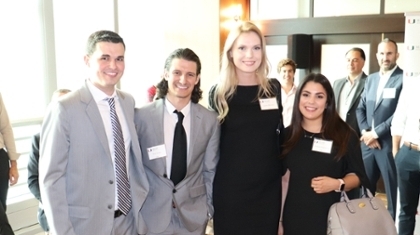With their focus on the social benefits of the proposed $420 million project, Mion and his fellow students, Carolina Dominguez, Troy Gulec and Laura Stevens, took second place and a $7,500 prize in Miami Business School’s third annual Impact Investing and Commercial Real Estate Case Competition, which concluded on April 5 at the Conrad Hilton.
“We had five great teams participate from South Florida, Pennsylvania, California and Washington, DC,” said Andrea Heuson, professor of finance, who organized the student competition with support from the Miami Business School Real Estate Advisory Board.
Three volunteer judges – David Kern, executive director, J.P. Morgan in Tampa; Manual Martin, managing director, Nuveen Real Estate’s U.S. Retail Sector platform; and Karayznya Pozniak, investment analyst, PGIM Real Estate in New York – evaluated each proposal for its social, environmental and economic merits, as well as financial returns.
Taking first place with a $25,000 prize was a three-person team from the University of Pennsylvania’s Wharton School. Their “The Ascension Church and Sheridan School Revitalization Project” called for renovating a five-building block in Philadelphia’s Kensington neighborhood. The historic Ascension church, now abandoned except for opioid users, would become a modern new facility leased to the Sheridan School, now located at the other end of the block. Along with creating a safe new campus, the $20.5 million projects would convert the school’s current buildings into 64 units of modern affordable multifamily housing.
The third-place award of $5,000 went to the George Washington University student team for “Deanwood Community Development,” a $53 million mixed-use project on the District of Columbia’s northeast side. Their project called for 217 residential units, commercial areas, green space and parking in an Opportunity Zone, providing tax advantages to potential investors.
A four-person team from Florida International University (FIU) presented “Little River Flats,” a $63.8 million mixed-use development near I-95 in the City of Miami’s 79th Street Corridor. Taking advantage of convenient transit access, Little River Flats would include 360 workforce-housing units, as well as ground-floor retail, a central courtyard and shared community space.
The fifth finalist team came from the University of Southern California (USC) with “Normandie Lofts and the Los Angeles County Naturally Occurring Affordable Housing (NOAH) Impact Investment Fund.” Their $10.5 million project involved the renovation of the 50-unit Normandie Lofts building north of downtown Los Angeles, using tax abatements and other incentives to reduce the rent burden on tenants.
Reflecting on the competition, USC business student Hector Arechiga de Leon, said the Normandie Lofts project offered a triple bottom line for investors: environmental, social and financial returns. His teammate, public policy student Jonathan Bates, said, “The social impact is what makes the University of Miami impact investing competition unique. It’s important for all of to know that real estate development doesn’t have to displace people. Instead, it can be a positive tool for changing, meeting the needs of those who are most in need of assistance.”

